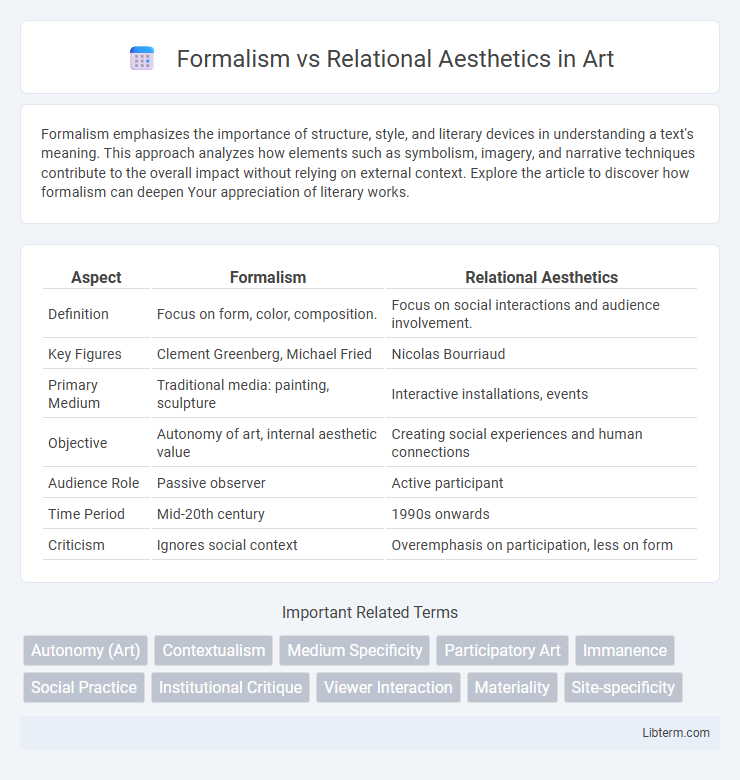Formalism emphasizes the importance of structure, style, and literary devices in understanding a text's meaning. This approach analyzes how elements such as symbolism, imagery, and narrative techniques contribute to the overall impact without relying on external context. Explore the article to discover how formalism can deepen Your appreciation of literary works.
Table of Comparison
| Aspect | Formalism | Relational Aesthetics |
|---|---|---|
| Definition | Focus on form, color, composition. | Focus on social interactions and audience involvement. |
| Key Figures | Clement Greenberg, Michael Fried | Nicolas Bourriaud |
| Primary Medium | Traditional media: painting, sculpture | Interactive installations, events |
| Objective | Autonomy of art, internal aesthetic value | Creating social experiences and human connections |
| Audience Role | Passive observer | Active participant |
| Time Period | Mid-20th century | 1990s onwards |
| Criticism | Ignores social context | Overemphasis on participation, less on form |
Defining Formalism: Art’s Autonomous Language
Formalism defines art as an autonomous language that emphasizes the intrinsic qualities of form, color, line, and composition over external contexts or narratives. It prioritizes visual elements and aesthetic experience within the artwork itself, distinguishing art as a self-referential system. This approach contrasts with relational aesthetics, which focuses on social interactions and audience engagement rather than independent formal properties.
Core Principles of Relational Aesthetics
Relational Aesthetics centers on human interactions and social contexts as the primary medium of art, emphasizing participatory experiences over isolated formal qualities. It challenges Formalism's focus on autonomous art objects by prioritizing intersubjective encounters, collective engagement, and the creation of temporary communities within the artwork's space. Core principles include the facilitation of dialogue, the blurring of boundaries between artist and audience, and the integration of everyday social practices into artistic expression.
Historical Development of Formalist Thought
Formalist thought emerged in the early 20th century, emphasizing intrinsic qualities such as composition, color, and form over content or context, with key proponents like Clive Bell and Clement Greenberg shaping its principles during modernism. This approach prioritized the materiality and visual elements of artwork, influencing movements such as Abstract Expressionism and Minimalism. Formalism's historical development set the stage for subsequent critiques, including Relational Aesthetics, which shifted focus toward social context and viewer interaction rather than isolated formal qualities.
Emergence and Influence of Relational Art
Relational Aesthetics emerged in the 1990s as an art movement challenging Formalism's focus on autonomous, object-centered works by emphasizing social interactions and participatory experiences within the artwork. Pioneered by Nicolas Bourriaud, Relational Art prioritizes human relationships and encounters, transforming art into a platform for community engagement and collective meaning-making. This shift influenced contemporary art practices by expanding the definition of artistic value beyond purely formal qualities to include relational dynamics and audience involvement.
Key Practitioners: Formalist vs Relational Artists
Key practitioners of Formalism include artists such as Piet Mondrian and Kazimir Malevich, who emphasized abstract forms, geometric shapes, and formal qualities like color and composition. Relational Aesthetics features artists like Nicolas Bourriaud, Rirkrit Tiravanija, and Liam Gillick, who prioritize social interactions and audience participation as central elements of the artwork. Formalist artists focus on autonomous visual language, whereas relational artists engage communal experiences and contextual dialogues within gallery spaces.
Audience Engagement: Passive Viewing and Active Participation
Formalism emphasizes passive viewing where aesthetic appreciation derives from the artwork's intrinsic qualities like composition and technique, fostering a contemplative and detached audience experience. In contrast, Relational Aesthetics centers on active participation, inviting viewers to engage socially and collaboratively, transforming the audience into co-creators within interactive environments. This paradigm shift redefines the role of art as a dialogic process that prioritizes communal experience over isolated observation.
Space, Context, and Meaning in Art
Formalism emphasizes the autonomous space of artwork, focusing on intrinsic visual elements like color, line, and composition, detached from external context or narrative. Relational Aesthetics redefines art as social interstice, where meaning emerges through audience interaction and shared experiences within specific contexts, transforming space into a participatory environment. This shift from isolated form to contextual engagement highlights how meaning in art is no longer contained solely within the object but produced through relational dynamics and spatial-temporal interaction.
Materiality vs Social Interaction
Formalism emphasizes the intrinsic materiality of art, focusing on composition, color, texture, and form as essential elements that define aesthetic value. Relational Aesthetics shifts the emphasis from physical materials to social interaction, treating art as a platform for communal experiences and participatory engagement. This contrast highlights the debate between art as a self-contained object versus art as a dynamic social process.
Critical Debates and Theoretical Perspectives
Formalism emphasizes the intrinsic qualities of art such as color, line, and composition, advocating for an autonomous aesthetic experience detached from social or political contexts. Relational Aesthetics, introduced by Nicolas Bourriaud, shifts the focus to art as a catalyst for human interactions and social dynamics, challenging traditional notions of authorship and spectatorship. Critical debates revolve around the political efficacy of relational art versus formalism's perceived detachment, with theorists questioning whether relational practices genuinely foster community engagement or risk commodification within neoliberal frameworks.
Future Directions: Beyond Formalism and Relational Aesthetics
Future directions in contemporary art critique emphasize interdisciplinary practices that transcend the rigid structures of Formalism and the interactive focus of Relational Aesthetics by integrating digital technology, social activism, and immersive experiences. Emerging frameworks prioritize participatory narratives and networked communities that challenge traditional aesthetic boundaries while fostering dynamic exchanges between artwork, audience, and environment. This evolution encourages art to function as a catalyst for socio-political dialogue and systemic transformation beyond purely formal or relational concerns.
Formalism Infographic

 libterm.com
libterm.com